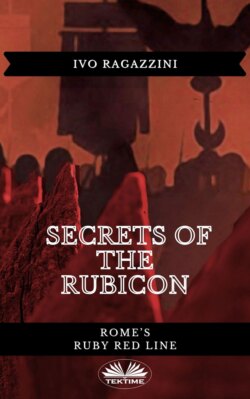Читать книгу Secrets Of The Rubicon - Ivo Ragazzini - Страница 6
What was the real Rubicon?
ОглавлениеYou should have understood this already from the conversation between Caesar and Hortensius, but let's try to summarize what has happened over time.
For centuries historians have debated and puzzled about what the real Rubicon was because of the fact that according to historical sources, legends and geological reconstructions, it now seems to have been a river that passed near Cesena, now other rivers between Savignano and Santarcangelo di Romagna,11 which was true in a way, but a few details were lacking that created a little confusion.
The confusion was related to the fact that long before, at the time of the Consul Flaminius, the Romans had created a defense made up of three defensive lines arranged one behind the other, as instructed by the military technique of the time, to stop no one less than Hannibal12 who had crossed the Alps with his troops and some elephants and would descend towards Rome by way of the Via Flaminia. Its construction had been completed a few years before, and the people in the area had named it Roman-Dia and also Roman-Via, which meant, if you prefer, Roman Crossing or Way to Roma.
The names Romània, Romandiola and the current Romagna were derived from these terms.
The final defensive line of the Rubicon had been drawn almost entirely on the river that is known today as the Uso.
The other two lines of the Rubicon were: one on the Pressatellum river today called Pisciatello and the other on the river now called Fiumicino. And probably both, if not all three, were linked by canals and hydraulic locks to the mountain springs of the Urgon, another river whose name historians believe meant Rubicon in the Romagna dialect, but which in Etruscan meant something else, as you will read more about later.13
Several miles of that boundary on the Uso river were cordoned off by a row of tall wooden poles and boards held together by iron and metal brackets and, until 1750, remnants of those palisades still existed on the banks of the Uso river, so much so that the farmers there used to take them to make agricultural tools.
If you now think that such a work was too large or impossible for the Romans, you should know that Crassus, a contemporary triumvirate of Caesar, created a similar work around 70 BCE, which divided Calabria in two, from the Tyrrhenian to the Ionian coast, with a four meter high palisade, to isolate the revolt of Spartacus and his rebel gladiators who had taken refuge in Aspromonte.
Moreover, the Rubicon had stones and red cultured sand on the Uso river that no longer exist today, but had been in existence until the end of the 1700s, as the academic historians of the time reported and argued about for a long time, theorizing that the Romans had colored them red to make it clear that this was the Rubicon.
However, those were not really stones and sand that the Romans had purposely colored red, but the ruby-red pigment that had fallen to the ground once the color on the wooden palisade had been swept away little by little by rain and floods, as time passed and the wood of the palisade had rotted.
Furthermore, opening barriers and water channels upstream from the sources of the Urgon would have swelled the Rubicon; the steep banks14 were raised artificially to sink those attacking and attempting to cross it on foot or on horseback into the mire, not to mention Hannibal's elephants.
The land, where the Rubicon was located, was called Roman-dia, diameter, district or Roman area, since the land was used by the legions to cross or camp entire units of legionaries, before entering the Roman territory or to recompose new legions, including veterans and those waiting nearby to be enlisted before marching to the north and the Gauls.
Therefore, when someone says that Romagna has always been a happy and hospitable land full of festivals and entertainment, they are telling the truth, because it was true even then, as was all the land along the border, where the legionaries from various places set down their arms, collected their reward and devoted themselves to various festivities and leisure time, while waiting for new engagements and assignments.
And perhaps it is not even a coincidence that many German citizens and those from northern Europe have continued to come to Romagna for their holidays for centuries and consider it their second home, but there is more to be learned about this.
